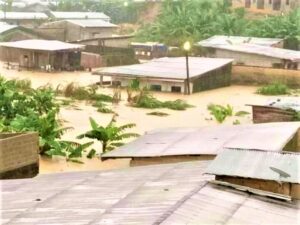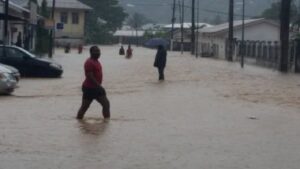August 21, 22 and 23, 2020 have gone down the anal of Cameroon history as the days thousands of Cameroonians in some towns and villages came face to face with the ugly face of nature, depicting a typical scenario of nature’s will wheeling against man’s will. From Edea to Douala, Santchou, Njoagwi-Fotabong III and Nkongho-Mbo, the wailing was total with many left in a complete state of topsy turvy. Induced by torrential downpour, the floods and or landslides caused widespread material damage, rendered hundreds homeless with a few deaths recorded in some of the affected areas.
Circa 900 Families Displaced in Douala

After an all-night non-stop down pour, inhabitants of Cameroon’s economic capital got up the morning of August 21, 2020 in waters. Several houses in the Makepe Missoke, Bonamoussadi New bell, Bepanda, Mabanda, Akwa, Nkololoun, Bongo Cite Berge, Carriere de tete, and Bonaberi were completely engulfed by floods. Roads were covered and bridges damaged disrupting traffic blocking scores of workers from reaching their job sites.
According to the Governor of the Littoral Region, Samuel Ivaha Diboua, about 900 families have been displaced following the flood, beside widespread material damage. Visiting the country’s economic hub, August 24, 2020, to assess the impact of the flood, Cameroon’s Minister of Territorial Administration, Paul Atanga Nji, blamed the natural disaster on invasion of wetlands. He urged occupants of such areas to leave or be forced out. This, without suggesting where they should and go to.
Santchou-Dschang Road Damaged, 185 Households Affected.

In Santchou, a locality in the Menoua Division, West Region of Cameroon, information from local authorities indicates that the torrential rains of August 21, 2020 collapsed six houses and destroyed185 homes. Fish ponds and farms were destroyed and part of the Dschang-Santchou highway damaged, paralyzing circulation.
In the wake of this natural disaster, the Governor of the West Region, Awa Fonka Augustine, in a press release cautioned truck drivers and other heavy duty vehicles to avoid the Bamoungoum-Dschang-Santchou- Melong corridor. The Governor also implored adjacent communities to the Elienti river to leave as the rains persist. Meanwhile, the Minister Territorial Administration, Paul Atanga Nji, visited the town Tuesday August 25, 2020 to evaluate the damages caused by the flood and landslide. The minister’s visit also saw the distribution of Presidential Biya’s emergency assistance to over 300 victims.
Over 70 families affected in Edea

Situated some 55 kilometers away from Douala, the heavy rains breaking Friday August 21, 2020 did not leave Edea indifferent. Over 70 families were submerged with enormous material damages recorded. In a visit to the city, August 24, 2020, Minister Paul Atanga Nji called on victims to desist from constructing in disaster-prone zones to avoid being hit again. He noted that some of the victims had received compensation to leave the area considered risky but never left. The visit culminated in the distribution of gifts including mattresses, blankets and foot stuff from President Paul Biya to the over 70 affected families.
Over 7 Dead, Scores of Homes Destroyed in Nkongho-Mbo

Over in Nguti Subdivision, Kupe Muanenguba Division-South Region of Cameroon, floods from the heavy rains of August 21 and 22, 2020 brought untold wailing to scores of families Nkongho-Mbo with at least seven persons feared dead. In an interview granted the state radio, Wednesday August 26, 2020, the Member of Parliament, MP, for Nguti, Hon. Fonge Julius, said three persons died following the floods, one carried out by running streams, and others buried in the mud. The floods and landslides are said to have also destroyed watersheds and farmlands with heaps of mud deposited on major roads making circulation of bikes and cars very difficult if not impossible. Electric poles and the lone electric transformer were reportedly destroyed plunging the entire area in darkness. Upset by the wrath of nature upon his people, the MP for Nguti, Honorable Chief Dr Julius Fonge, made a clarion call to the Cameroon Government, charitable organizations and well-wishers to come to the rescue of his people. No information has filtered on any planned humanitarian assistance to the affected population in this area by the government.
Hundreds Homeless in Njoagwi-Fotabong III, at Least 1 dead.

The people Njoagwi – Fotabong III of Fotem Subdivision in the Lebielem Division, were greeted by a 48 hours of non-stop rains August 20 to 22, 2020. This torrential rain culminated in a landslide that consumed at least one person, destroyed scores of houses, livestock, farmlands, and other valuables. Part of the Fon’s palace in Njoagwi – Fotabong III is said to have been destroyed by the mudflow, which also blocked several roads and footpaths in the village. This has placed the people of this community in a fix, with their eyes looking up to the government, elite, humanitarian organizations and well-wisher to avert their plight.
While the Government embarks on providing humanitarian assistance to those affected by these natural disasters, it is more preponderant than ever before to take measures to avert future floods and landslides, which have become a yearly routine occurring in the same areas. There is the urgent need for the putting in place of a good drainage and effective land use planning system in key urban areas, with adequate follow up to prevent construction on wetlands and water ways to limit future flood and reduce it impacts. The Government should also step up efforts in realizing her 2017 commitments of restoring over 12 million hectares of deforested and degraded land by 2030 as part of the Bonn Challenge initiative. This, together with a mechanism to limit deforestation will reduce the rate of landslide and its impact on the population.
By Ndimuh B. Shancho







